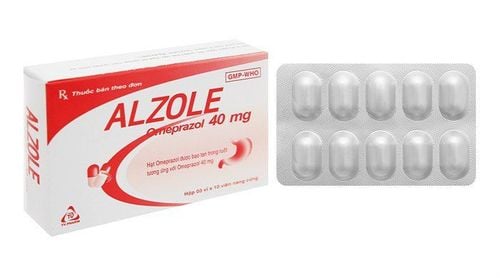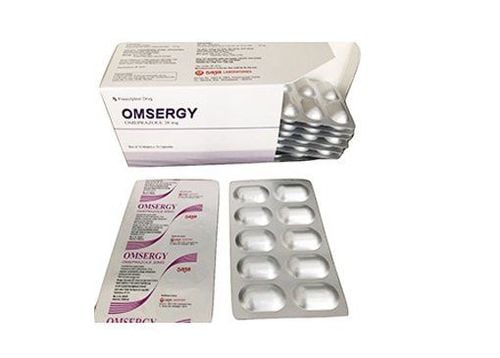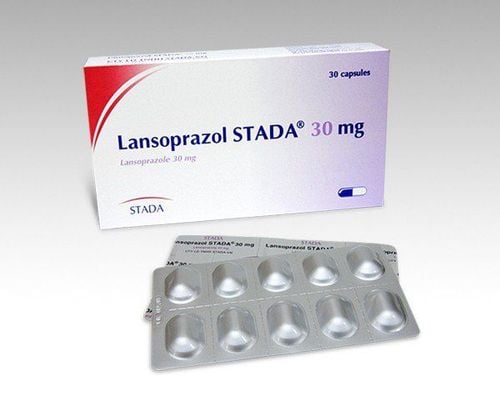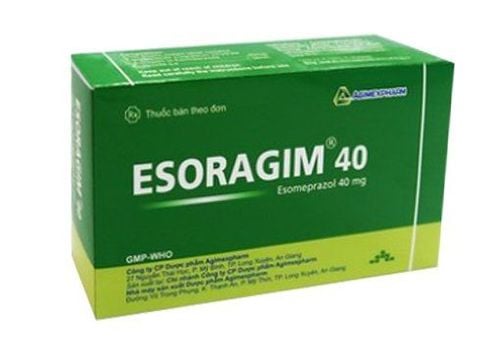This is an automatically translated article.
Facidintas has the main active ingredient is Famotidine, an antihistamine at the H2 receptor. The drug is indicated in the treatment of gastric ulcer, duodenal ulcer, gastroesophageal reflux disease or diseases that cause increased secretion of gastric acid in the gastrointestinal tract such as Zollinger-Ellison syndrome.
1. What is Facidintas?
Facidintas drug with the main active ingredient is Famotidine, a competitive inhibitor of the effect of histamine at H2 receptors in gastric parietal cells. Therefore, the drug has the effect of reducing gastric acid secretion both at night and day basal conditions, as well as when stimulated by food or by histamine. Famotidine's H2-receptor antagonist activity is slow to recover, due to the slow dissociation of the drug from the receptor. The inhibitory effect on gastric acid secretion by stimulation of Famotidine is 20 - 150 times stronger than that of Cimetidine and 3 - 20 times that of Ranitidine. By reducing gastric acid secretion, Famotidine indirectly causes a decrease in pepsin secretion. In general, the drug Facidintas has a protective effect on the stomach lining when it is irritated by certain drugs such as aspirin or other non-steroidal anti-inflammatory drugs.
2. Indications of the drug Facidintas
Facidintas drug is indicated in the following pathologies:
Active duodenal ulcer, maintenance treatment in duodenal ulcer. Active gastric ulcer. Gastroesophageal reflux disease. Diseases causing increased gastric acid secretion in the gastrointestinal tract such as Zollinger-Ellison syndrome (proton pump inhibitors are more effective), multiple endocrine neoplasia. Helps relieve symptoms of heartburn, heartburn, indigestion caused by increased gastric acid. Note that Facidintas is contraindicated in patients with hypersensitivity to the active ingredient Famotidine, other histamine H2-receptor antagonists or to any of the ingredients in the formulation.
3. Dosage and how to use Facidintas
Dosage may vary depending on the disease or the patient's overall health. The following is a reference dose of Facidintas in some cases:
Treatment of active stomach ulcers: It is recommended to take 1 tablet per day at bedtime. Treatment of acute duodenal ulcer: It is recommended to take 1 tablet per day at bedtime or 20mg each time, twice a day. Most patients recover within 4 weeks, some require longer treatment, for 6-8 weeks. For maintenance treatment after an acute duodenal ulcer has healed to reduce recurrence, 20 mg once daily at bedtime is recommended. Children 1 - 16 years, the recommended dose is 0.5mg/kg once at bedtime or in 2 divided doses, the maximum total daily dose is 40mg. Treatment of gastroesophageal reflux: Adults, 20mg / time, 2 times a day, for up to 6 weeks is recommended. In the case of erosive reflux esophagitis, patients should take 20 or 40 mg each time, twice a day, for up to 12 weeks. Maintenance treatment to reduce recurrence, recommended to take 20mg each time, 2 times a day. For children, the dose will vary according to age: Children 1 - 16 years old: The starting dose of Facidintas is 1mg/kg per day, divided into 2 times, can be increased to 40mg, 2 times a day. Children < 3 months: Recommended oral dose of 0.5mg/kg/time, up to 4 weeks. Children from 3 months to 1 year: 0.5mg/kg each time, 2 times a day, for up to 4 weeks. Note that there is no information on safety and effectiveness when used for more than 4 weeks in children under 1 year of age. Diseases of increased gastric secretion (Zollinger - Ellison, multiple endocrine neoplasia): The recommended starting dose in adults is 20mg/time, every 6 hours. However, in some patients, the starting dose may be higher. The dose should be adjusted according to the individual patient and the duration of treatment according to clinical requirements. Normally, the oral dose range is from 20 to 160mg each time, every 6 hours, the maximum can be increased to 800mg/day, divided into several times in some patients if they are seriously ill. Patients with severe renal impairment (creatinine clearance less than 10ml/min): The dosing interval should be extended to 36-48 hours.
4. Side effects of the drug Facidintas
Patients using Facidintas may experience some unwanted effects including:
Common
Central nervous system: Headache, dizziness. Gastrointestinal: Abdominal pain, constipation, diarrhea. Uncommon
Body as a whole: Fever, fatigue, asthenia Cardiovascular: Arrhythmia, atrial - ventricular obstruction, palpitations, increased blood pressure. Gastrointestinal: Abnormal liver enzymes, nausea, vomiting, loss of appetite, heartburn, flatulence, belching, dry mouth. Hypersensitivity reactions: Anaphylaxis, angioedema, eye edema, urticaria, rash, conjunctival congestion. Musculoskeletal: Musculoskeletal pain, cramps, arthralgia. Neurological: Convulsions, mental disorders such as confusion, hallucinations, agitation, depression, anxiety, paresthesia, insomnia, somnolence. Patients with renal impairment are at higher risk of CNS adverse events. Renal: Increased BUN or serum creatinine, proteinuria. Respiratory: Bronchospasm, interstitial pneumonia, community-acquired pneumonia. Skin: Hair loss, acne, pruritus, dry skin, flushing Endocrine: Famotidine has little effect on serum prolactin concentrations and has no anti-androgen effect. However, doubling the dose for several months can cause hyperprolactinemia and breast tenderness. Rare
Blood: Agranulocytosis, pancytopenia, leukopenia, thrombocytopenia. Skin: Toxic epidermal necrolysis, Stevens-Johnson syndrome. Endocrine: Impotence, gynecomastia in men, sexual dysfunction.
5. What are the precautions when using Facidintas?
Vitamin B12 Deficiency: Famotidine and other H2 antihistamines may decrease vitamin B12 absorption and thereby decrease serum B12 levels. Renal Impairment: Facidintas should be used with caution in patients with renal impairment due to the increased risk of QT prolongation, dosage adjustment may be required. Elderly: Use with caution with Facidintas Children: Use of gastric acid-suppressing drugs, including proton pump inhibitors and H2 blockers, has been associated with an increased risk of developing acute gastroenteritis and community-acquired pneumonia in pediatric patients. Pregnancy: Famotidine crosses the placenta. There are currently no adequate studies on the use of Famotidine during pregnancy, so Facidintas should be used during pregnancy only when clearly needed. Lactation: Famotidine may be excreted in breast milk. Because of the potential for serious adverse reactions in the infant, a decision must be made whether to discontinue nursing during Facidintas or to discontinue it, depending on the role of the drug in the mother.
6. Drug interactions
Some drugs when used concurrently with Facidintas can cause interactions and lead to many adverse reactions or affect the effectiveness of therapy. The following are some interactions to be aware of while using Facidintas:
Food may slightly increase and antacids may slightly decrease the bioavailability of Famotidine, but should not have an important effect on the clinical effect. Famotidine can be used concomitantly with other antacids. Limit the use of food and drinks containing Xantin when taking Facidintas. Avoid alcohol because it can irritate the stomach lining. Similar to other histamine H2-receptor antagonists, the effect of famotidine on gastric pH may affect the absorption of some other drugs. Famotidine does not inhibit drug metabolism via the cytochrome P450 enzyme system in the liver. Famotidine also does not affect the metabolism and clearance of Aminopyrin. Avoid concomitant use of Facidintas with Delavirdin, Erlotinib, Mesalamin. Facidintas may increase the effects and toxicity of saquinavir. Facidintas may reduce the effect of antifungal drugs (azol derivatives), Cefpodoxime, Cefuroxime, Fosamprenavir, Indinavir, iron salts, Mesalamin and Nelfinavir. Above is information about the uses, dosage and precautions when using Facidintas. If you have questions or need more information about Facidintas, you should contact your doctor or pharmacist.













